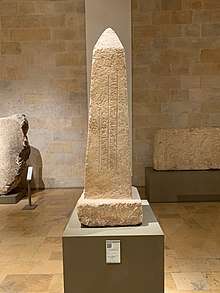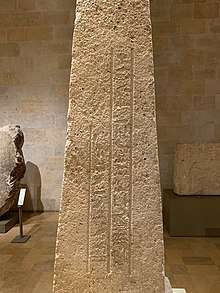Abishemu obelisk
The Abishemu obelisk or the Abichemou obelisk is a 1.25 meter limestone obelisk dedicated to the Phoenician king Abishemu I of Byblos. The obelisk is decorated with two lines of inscriptions in Egyptian hieroglyphics. It was created in c.1800 BCE, and was unearthed in the 1950s by Maurice Dunand in the Temple of the Obelisks.
| Abishemu obelisk | |
|---|---|
 The obelisk in its current location | |
| Material | Limestone |
| Size | 1.45 meters (1.25 meters above the plinth) |
| Writing | Egyptian hieroglyphs |
| Created | c.1800 BC |
| Discovered | c.1950 |
| Present location | National Museum of Beirut |
| Identification | DGA 17917 |
Although only approximately a dozen words long, the obelisk contains:
- the name of one of the oldest known kings of Byblos, Abishemu I
- the earliest description of an ethnic group later considered to be among the purported "Sea Peoples", transliterated as Kukunnis, son of Lukka" (in analysis of the Sea Peoples, Lukka have been proposed as "Lycians".[1][2]
- a reference to "Herishef", considered by Dunand to be the Egyptian name of the Canaanite god Resheph, and thus giving the alternate name "Temple of Resheph" for the Temple of the Obelisks[3]
The obelisk is the only example of a complete obelisk with a true pyramidion found in the Temple of the Obelisks; most of the others were rough steles.[4] It consists of a square plinth at the bottom, a tapering shaft and with a pyramidion at the top.[4]
Inscription

Transcribed:[4]
(1) mry Ḥr-š·f ḥ:ty-' n Kpny 'b-šmw wḥm 'nḥ
(2) ...f Kwkwn ś: Rwqq m:' ḥrw
Translated:[4]
Beloved of Arsaphes [also translated Herishef], Abishemu, prince of Byblos, renewed in life, his
..., Kukun, son of 'the Lycian' justified (i. e., deceased).
Notes
- Bryce, T. R. (1974). "The Lukka Problem – And a Possible Solution". Journal of Near Eastern Studies. 33 (4): 395–404. doi:10.1086/372378. JSTOR 544776.
- Woudhuizen, Frederik Christiaan (2006). The Ethnicity of the Sea Peoples (Ph.D.). Erasmus Universiteit Rotterdam, Faculteit der Wijsbegeerte. p. 31. hdl:1765/7686.CS1 maint: ref=harv (link)
- Münnich 2013, p. 120-121.
- Albright 1959, p. 33.
References
| Wikimedia Commons has media related to Abishemu obelisk. |
Edition princeps
- Maurice Dunand, Foilles de Byblos, volume 2, p. 878, no. 16980; and plate XXXII number 2
Seconard sources
- Albright, William F. (1959). "Dunand's New Byblos Volume: A Lycian at the Byblian Court". Bulletin of the American Schools of Oriental Research. 155: 31–34. JSTOR 1355673.CS1 maint: ref=harv (link)
- Miniaci, Gianluca (2018). "Deposit f (Nos. 15121–15567) in the Obelisk Temple at Byblos". Ägypten Und Levante / Egypt and the Levant. 28: 383. JSTOR 26664997.
- Münnich, Maciej M. (2013). The God Resheph in the Ancient Near East. Mohr Siebeck. ISBN 978-3-16-152491-2.CS1 maint: ref=harv (link)